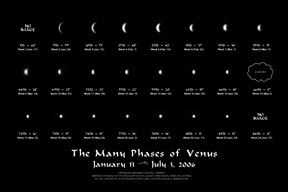Venus

Click Image for Larger Version
The closest planet to Earth ... generally. And since it is generally the closest, and because its voluminous atmosphere (nearly 100x as heavy as Earth's) reflects about 85% of the light that hits it, Venus is THE brightest object in the sky, excluding the Sun and Moon.
Venus is notoriously difficult to photograph because the farthest it gets from the Sun (called "greatest elongation") is about 46.5° (about 93 full moon diameters). So it is an early morning or evening object (the Morning and the Evening Star), but it is also visible during the day, which is when I will be photographing it. Because its atmosphere is so thick, surface features cannot be seen from Earth, and only when imaged in ultraviolet light, which our atmosphere luckily screens, do cloud features become visible.
Venus is known as an "inferior" planet relative to Earth, which means that it lies closer to the Sun than Earth. Because it lies closer to the Sun, Venus displays phases as seen from Earth, just as the Moon does. Because Venus goes between 0.3 A.U. from us at its closest, during its new phase, and 1.7 A.U. from us at its farthest, its size changes by a factor of 6 during a cycle of phases. The change from new through full takes approximately 10 months; even though Venus' year is about 245 Earth days, Earth travels in its orbit, too, so acts to slow down the changing phases.
On January 13, 2006, Venus passed between Earth and the Sun, which resulted in the "new" phase of Venus; the planetary configuration is known as "inferior conjunction." It was a full arcminute (1/30 the size of the full Moon) in diameter as seen from Earth, if it could have been seen from Earth. It will displayed its "full" phase of 100% illuminated as seen from Earth between October 6 and November 19, 2006, so centered on October 25, 2006. On this date, Venus was approximately 9.7 arcsec in diameter as seen from Earth.
Because of the huge range of phases and the change in sizes, a very interesting - though involved - project would be to image Venus from the same location on Earth, with the same telescope, with the same camera, during the entire 10.5-month new through full change. Such a project is what I attempted here. In mid-June, however, it was tiny and not changing much at all. As a result, I stopped after 24 weeks, the result of which is shown above.
The final montage is a document 39"x26", so it has the correct proportions to be printed at a 2:3 ratio, which is what many of the sizes I offer are. It also is approximate computer desktop proportions, as well.
| Image Dates | Various |
| Exposure Length | Various |
| Number of Images | Various; with Adobe PhotoShop using Screen Layer Mode |
| Camera | Canon EOS Digital Rebel XT |
| Telescope | 16" SBO Telescope at CU Boulder |